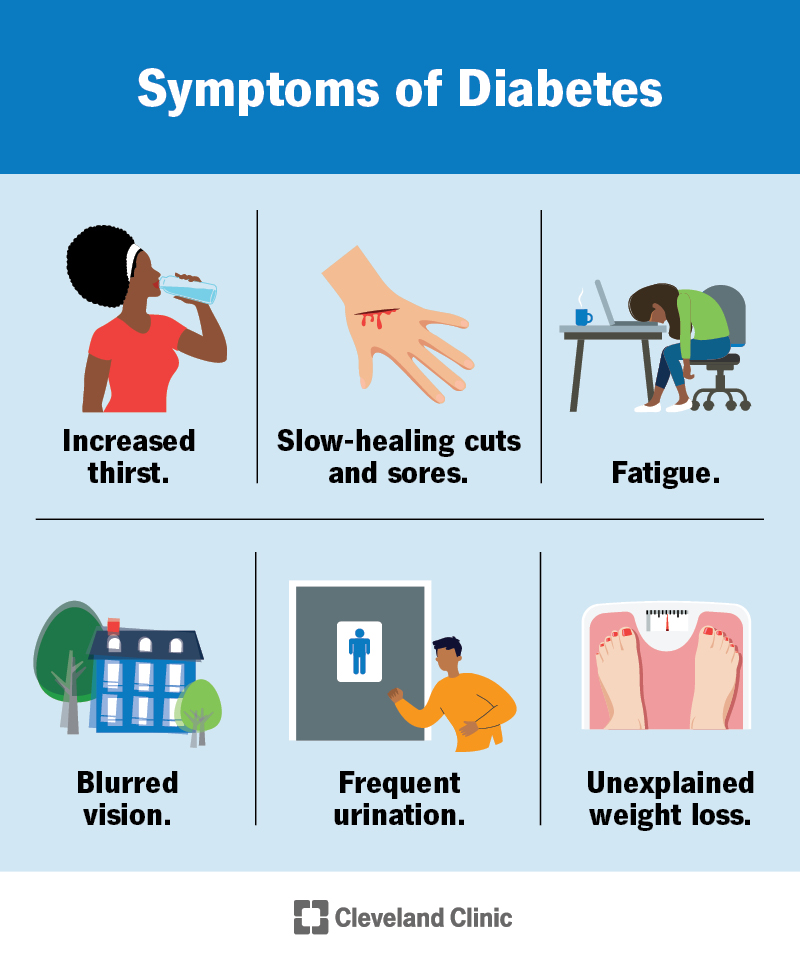What It Is, Causes, Symptoms, Treatment & Types

What is diabetes?
Diabetes is a condition that happens when your blood sugar (glucose) is too high. It develops when your pancreas doesn’t make enough insulin or any at all, or when your body isn’t responding to the effects of insulin properly. Diabetes affects people of all ages. Most forms of diabetes are chronic (lifelong), and all forms are manageable with medications and/or lifestyle changes.
Glucose (sugar) mainly comes from carbohydrates in your food and drinks. It’s your body’s go-to source of energy. Your blood carries glucose to all your body’s cells to use for energy.
When glucose is in your bloodstream, it needs help — a “key” — to reach its final destination. This key is insulin (a hormone). If your pancreas isn’t making enough insulin or your body isn’t using it properly, glucose builds up in your bloodstream, causing high blood sugar (hyperglycemia).
Over time, having consistently high blood glucose can cause health problems, such as heart disease, nerve damage and eye issues.
The technical name for diabetes is diabetes mellitus. Another condition shares the term “diabetes” — diabetes insipidus — but they’re distinct. They share the name “diabetes” because they both cause increased thirst and frequent urination. Diabetes insipidus is much rarer than diabetes mellitus.
What are the types of diabetes?
There are several types of diabetes. The most common forms include:
- Type 2 diabetes: With this type, your body doesn’t make enough insulin and/or your body’s cells don’t respond normally to the insulin (insulin resistance). This is the most common type of diabetes. It mainly affects adults, but children can have it as well.
- Prediabetes: This type is the stage before Type 2 diabetes. Your blood glucose levels are higher than normal but not high enough to be officially diagnosed with Type 2 diabetes.
- Type 1 diabetes: This type is an autoimmune disease in which your immune system attacks and destroys insulin-producing cells in your pancreas for unknown reasons. Up to 10% of people who have diabetes have Type 1. It’s usually diagnosed in children and young adults, but it can develop at any age.
- Gestational diabetes: This type develops in some people during pregnancy. Gestational diabetes usually goes away after pregnancy. However, if you have gestational diabetes, you’re at a higher risk of developing Type 2 diabetes later in life.
Other types of diabetes include:
- Type 3c diabetes: This form of diabetes happens when your pancreas experiences damage (other than autoimmune damage), which affects its ability to produce insulin. Pancreatitis, pancreatic cancer, cystic fibrosis and hemochromatosis can all lead to pancreas damage that causes diabetes. Having your pancreas removed (pancreatectomy) also results in Type 3c.
- Latent autoimmune diabetes in adults (LADA): Like Type 1 diabetes, LADA also results from an autoimmune reaction, but it develops much more slowly than Type 1. People diagnosed with LADA are usually over the age of 30.
- Maturity-onset diabetes of the young (MODY): MODY, also called monogenic diabetes, happens due to an inherited genetic mutation that affects how your body makes and uses insulin. There are currently over 10 different types of MODY. It affects up to 5% of people with diabetes and commonly runs in families.
- Neonatal diabetes: This is a rare form of diabetes that occurs within the first six months of life. It’s also a form of monogenic diabetes. About 50% of babies with neonatal diabetes have the lifelong form called permanent neonatal diabetes mellitus. For the other half, the condition disappears within a few months from onset, but it can come back later in life. This is called transient neonatal diabetes mellitus.
- Brittle diabetes: Brittle diabetes is a form of Type 1 diabetes that’s marked by frequent and severe episodes of high and low blood sugar levels. This instability often leads to hospitalization. In rare cases, a pancreas transplant may be necessary to permanently treat brittle diabetes.
How common is diabetes?
Diabetes is common. Approximately 37.3 million people in the United States have diabetes, which is about 11% of the population. Type 2 diabetes is the most common form, representing 90% to 95% of all diabetes cases.
About 537 million adults across the world have diabetes. Experts predict this number will rise to 643 million by 2030 and 783 million by 2045.
link







